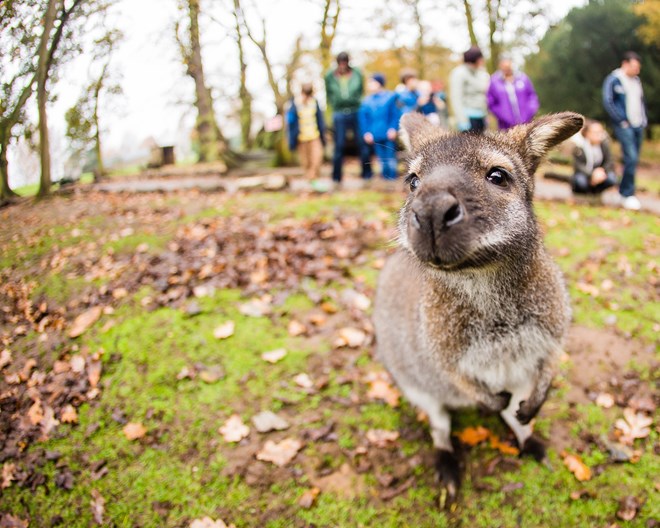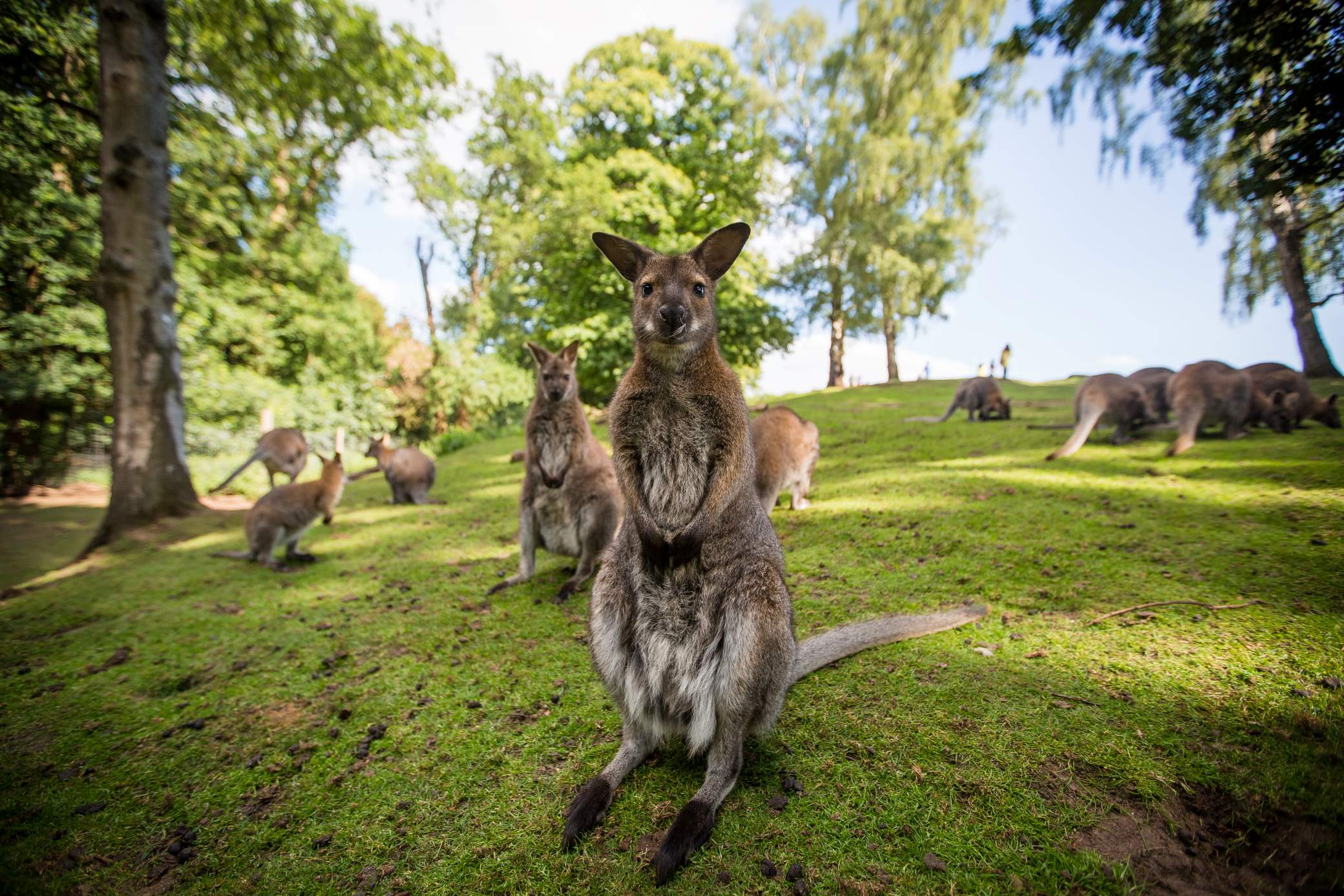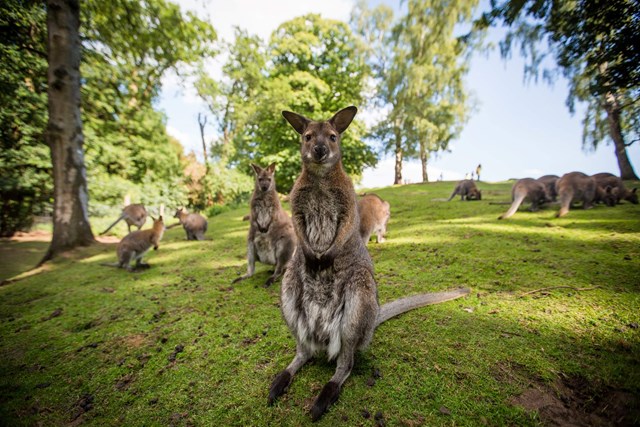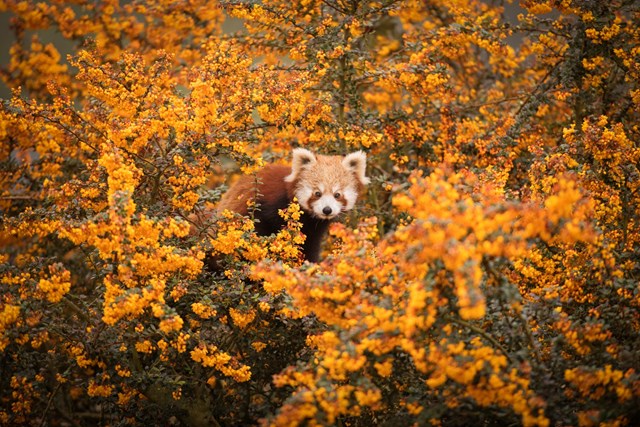
Overview
At Woburn Safari Park there is a large breeding group of red-necked wallabies. They roam freely in a large wooded area within their Australian Walkabout enclosure in the Foot Safari. Watch the keeper talk and feed at certain times of the day to get to know even more about this amazing species!
You will find them grazing on the grass, and on a sunny day laying out sunbathing. Around springtime there are always little joeys (baby wallabies) sticking their heads out of their mother’s pouches, so keep an eye out for them.

All about us
| Distribution: | Australia |
|---|---|
| Habitat: | Eucalyptus forest, open areas with shrub cover, and coastal heath. |
| Height: | Body length 65 - 92cm, tail length 62 - 86cm |
| Weight: | 11kg to 26kg |
| Lifespan: | 12 to 15 years |
| Threats: | Captured for fur and meat, culling as a pest, and deforestation. |
About us
Scientific name: Macropus rufogriseus
The red necked wallaby is found along the south east coast of Australia and the island of Tasmania. They are part of the macropod family, which includes wallabies, kangaroos, and wallaroos. This name comes from the Greek ‘makros’, meaning long, and ‘pous’ meaning foot. The red necked wallaby gets its English name from the patch of reddish fur around its neck and shoulders.

The red necked wallaby is named so because of a patch of red fur on their neck and shoulders. The rest of the body is a fawny grey colour. The chest and belly are white, with small patches of white on the cheeks, and the nose is a darker brown colour. They have longer ears than other wallabies. Their tails are proportionately nearly as long as their height, in larger individuals getting up to 862mm long. Males are generally bigger than females.
The feet of a wallaby are long, their family name ‘macropod’ comes from the Greek ‘makros’, meaning long, and ‘pous’ meaning foot, as it is a feature shared with all members of the family. These long feet , combined with large strong legs, are used to allow them to hop around at speeds of up to 30 or 40mph. The key to this speed is their tail, often nearly as long as their body, it acts as an extra leg, helping propel them when running. The legs are adapted with special tendons to give them the strength and elasticity to move at such high speeds, and to jump to impressive heights without damaging the leg or foot.
At slow speeds they will also use their short forearms to help them move along. These forearms are also used for grasping food, grooming, and for fighting.
Their eyesight is quite poor, but their eyes are located high on their head so that they have a wide field of vision, and can see any movements around them. Their sense of smell and their hearing is superior, and are mainly relied upon. Their sense of smell is so good that scientists have compared it to the ability of a shark to smell a drop of blood in the ocean. They use this to smell any predators. Their hearing is a key sense, used to detect any predators whilst grazing. Their ears can turn 180 degrees, independently, allowing them to scan around for unfamiliar noises.
Wallabies teeth are designed for grazing, and chewing of vegetation. They have a set of long incisors on their lower jaw which enable them to cut grasses, with a set of molars at the back of the jaw to allow the food to be chewed. As the wallaby grows their molars will move forward in the jaw and eventually fall out, being replaced by a new set. This happens four times in their life, and often very old individuals can be left with only one or two teeth. This is an unusual characteristic, shared by elephants and manatees.
Wallabies are marsupials, or pouched mammals. This means that they are part of a group of animals who give birth to undeveloped young, who are then moved to a pouch of skin to develop further. In wallabies this pouch is on the underbelly of the animals, and contains four teets to feed the young. These teets are capable of delivering two different types of milk, to feed both an infant in the pouch, and an infant which has recently left the pouch and still feeds. They also have a complicated reproduction system, with the ability to hold a fertilised embryo in stasis. They can hold the embryo in stasis until the current infant has left the pouch or depending on temperature conditions, this may mean holding off pregnancy for up to eight months until the climate is better.
Wallabies are herbivores, mostly grazing, but also eating tree leaves, known as browse. Their diet consists of around 75% grasses, and the rest is made of broad leaved plants, and emerging shoots and root plants.
Wallabies graze using specially adapted teeth; they have a set of long incisors on their lower jaw which enable them to cut grasses, with a set of molars at the back of the jaw to allow the food to be chewed. As the wallaby grows their molars will move forward in the jaw and eventually fall out, being replaced by a new set. This happens four times in their life, and often very old individuals can be left with only one or two teeth. This is an unusual characteristic, shared by elephants and manatees.
Wallabies are solitary animals, although they will often forage for food in groups of up to 30 animals. They are not territorial but each individual will have a home range which they feed in. The males tend to have larger home ranges than females, and during the winter months these ranges will be larger for both sexes. The home ranges of individuals will overlap, this is where large grazing groups will occur in areas with good resources. As they are not a social animal, even in large groups all individuals will keep alert and will not relax, there is no cooperation between them to alert of predators.
There is a hierarchy within wallabies, usually with the larger individuals being more dominant. Each will act dominant towards those below it and not to those above it. The males will fight for their status, as the more dominant males will be found near the females in season and ready to mate. Play and grooming will take place amongst similarly ranking individuals.
Wallabies have very underdeveloped vocal chords, and as a result can only make limited noises. They will often make a barking noise, or a hissing noise. Males will make a clucking type of noise when trying to mate a female, and the female will return with a hissing noise before mating occurs. Youngsters will call to their mothers when separated with a distress call. Foot thumping is used when an individual is alarmed, possibly to give a threatening warning, or possibly to alert others of danger.
Scent marking in wallabies is not a well researched field, but males do have scent glands on their chests, and have been seen to rub their scent on vegetation and on females who are in season. They have a very well developed sense of smell, compared by scientists of that of a shark detecting a drop of blood in the ocean. As they are not territorial, scent plays more of a role in predator detection.
Although there is a hierarchy between individuals, the dominant males will not stop lower ranking males from mating with females, once they have done so already. The male will court the female by using several vocal and physical queues. He will flick his tail, and forepaws, and will paw at the female’s rump.
Mating occurs from December to May, but can occur all year around in areas with better resources. The female comes into season, and is ready to breed, around every 33 days. Before the male starts courtship he will smell the female’s rump and her pouch to check if she is in season.
The female is pregnant for only 30 days, then she will give birth to a very small, but well developed baby, known as a joey. This joey will weigh less than 1g, and will be about the size of a bean, at around half an inch long. It is hairless, deaf, and blind, but is well developed enough to climb up to the pouch, following the direction of her fur. This can take up to fifteen minutes, and once there it will crawl into the pouch and attach itself to one of four teets. This teet will enlarge inside the joeys mouth, fusing it to it for the first four months. The joey will start to look out of the pouch at around five months old, and will start to come out of the pouch for short periods of time at about six months. At around eight to nine months they will be spending most of their time out of the pouch, and will soon be pushed out by the mother. At this stage they will still feed from the mother, until around twelve months when they are weaned.
Wallabies are capable of having three offspring at various stages of life all at once. They can have a joey which has left the pouch, but is still feeding, while having a young joey in the pouch, and can be pregnant. A fertilised egg can be held in a stage called embryonic diapauses, which is when the egg is dormant and will not continue to develop until the current joey leaves the pouch. Because of the ability to have joeys in these three stages the female can produce two different kinds of milk to cater for the two joeys.
Females become sexually mature at 14 months, and males at 19 months.
Natural predators include dingoes, Tasmanian devils, and eagles. Small or injured wallabies will be taken by quolls also.
Their main threat is humans. Deforestation threatens their habitat, taking away the sheltered forest areas in which they live. Accidental road deaths are also a large problem for them. In the past they were hunted for their fur and meat, although this has largely stopped now. There is a legal and governed harvest of wallabies for their meat, around 30,000 to 50,000 each year are taken for this.
Wallabies can become a pest species, especially in locations where they have been introduced. They can destroy crops, and supposedly cause conflict by competing with domestic cattle and sheep for grass. They have been found to hinder reforestation work, by trampling or eating young seedlings planted. It is for these reasons that there are often culls of red necked wallabies in some areas. They are protected in all regions of Australia but a licence to cull them can be obtained if they are a proven pest to farming. Around 45,000 are culled each year, with no overall effect on population numbers.
A baby wallaby is called a joey! Wallabies are capable of having three offspring at various stages of life all at once; they can have a joey which has left the pouch, but is still feeding, while having a young joey in the pouch, and can be pregnant.
A wallaby’s teeth grow just like an elephant, with new molars pushing the old ones forward and out of the mouth, and replacing them. They will have four sets of teeth in their life!
They are very good swimmers, using a doggy paddle style motion they can move through water easily.

